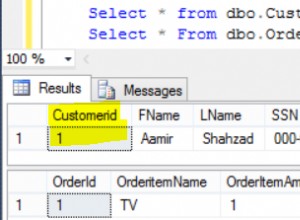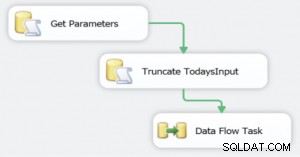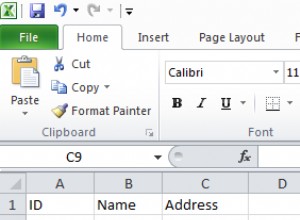Jeśli plik CSV nie jest zbyt duży i dostępny na komputerze lokalnym, csvkit to najprostsze rozwiązanie. Zawiera również szereg innych narzędzi do pracy z plikami CSV, więc jest to przydatne narzędzie wiedzieć ogólnie.
W najprostszym wpisaniu w powłoce:
$ csvsql myfile.csv
wydrukuje wymaganą CREATE TABLE Polecenie SQL, które można zapisać do pliku za pomocą przekierowania wyjścia.
Jeśli podasz również ciąg połączenia csvsql utworzy tabelę i prześle plik za jednym razem:
$ csvsql --db "$MY_DB_URI" --insert myfile.csv
Istnieją również opcje pozwalające określić smak SQL i CSV, z którymi pracujesz. Są one udokumentowane we wbudowanej pomocy:
$ csvsql -h
usage: csvsql [-h] [-d DELIMITER] [-t] [-q QUOTECHAR] [-u {0,1,2,3}] [-b]
[-p ESCAPECHAR] [-z MAXFIELDSIZE] [-e ENCODING] [-S] [-H] [-v]
[--zero] [-y SNIFFLIMIT]
[-i {access,sybase,sqlite,informix,firebird,mysql,oracle,maxdb,postgresql,mssql}]
[--db CONNECTION_STRING] [--query QUERY] [--insert]
[--tables TABLE_NAMES] [--no-constraints] [--no-create]
[--blanks] [--no-inference] [--db-schema DB_SCHEMA]
[FILE [FILE ...]]
Generate SQL statements for one or more CSV files, create execute those
statements directly on a database, and execute one or more SQL queries.
positional arguments:
FILE The CSV file(s) to operate on. If omitted, will accept
input on STDIN.
optional arguments:
-h, --help show this help message and exit
-d DELIMITER, --delimiter DELIMITER
Delimiting character of the input CSV file.
-t, --tabs Specifies that the input CSV file is delimited with
tabs. Overrides "-d".
-q QUOTECHAR, --quotechar QUOTECHAR
Character used to quote strings in the input CSV file.
-u {0,1,2,3}, --quoting {0,1,2,3}
Quoting style used in the input CSV file. 0 = Quote
Minimal, 1 = Quote All, 2 = Quote Non-numeric, 3 =
Quote None.
-b, --doublequote Whether or not double quotes are doubled in the input
CSV file.
-p ESCAPECHAR, --escapechar ESCAPECHAR
Character used to escape the delimiter if --quoting 3
("Quote None") is specified and to escape the
QUOTECHAR if --doublequote is not specified.
-z MAXFIELDSIZE, --maxfieldsize MAXFIELDSIZE
Maximum length of a single field in the input CSV
file.
-e ENCODING, --encoding ENCODING
Specify the encoding the input CSV file.
-S, --skipinitialspace
Ignore whitespace immediately following the delimiter.
-H, --no-header-row Specifies that the input CSV file has no header row.
Will create default headers.
-v, --verbose Print detailed tracebacks when errors occur.
--zero When interpreting or displaying column numbers, use
zero-based numbering instead of the default 1-based
numbering.
-y SNIFFLIMIT, --snifflimit SNIFFLIMIT
Limit CSV dialect sniffing to the specified number of
bytes. Specify "0" to disable sniffing entirely.
-i {access,sybase,sqlite,informix,firebird,mysql,oracle,maxdb,postgresql,mssql}, --dialect {access,sybase,sqlite,informix,firebird,mysql,oracle,maxdb,postgresql,mssql}
Dialect of SQL to generate. Only valid when --db is
not specified.
--db CONNECTION_STRING
If present, a sqlalchemy connection string to use to
directly execute generated SQL on a database.
--query QUERY Execute one or more SQL queries delimited by ";" and
output the result of the last query as CSV.
--insert In addition to creating the table, also insert the
data into the table. Only valid when --db is
specified.
--tables TABLE_NAMES Specify one or more names for the tables to be
created. If omitted, the filename (minus extension) or
"stdin" will be used.
--no-constraints Generate a schema without length limits or null
checks. Useful when sampling big tables.
--no-create Skip creating a table. Only valid when --insert is
specified.
--blanks Do not coerce empty strings to NULL values.
--no-inference Disable type inference when parsing the input.
--db-schema DB_SCHEMA
Optional name of database schema to create table(s)
in.
Kilka innych narzędzi również wykonuje wnioskowanie o schemacie, w tym:
- Apache Spark
- Pandy (Python)
- Płomień (Python)
- read.csv + twój ulubiony pakiet db w R
Każdy z nich ma funkcję wczytywania CSV (i innych formatów) do tabelarycznej struktury danych, zwykle nazywanej DataFrame lub podobnej, wnioskowania o typach kolumn w procesie. Następnie mają inne polecenia, aby albo napisać równoważny schemat SQL, albo przesłać DataFrame bezpośrednio do określonej bazy danych. Wybór narzędzia będzie zależał od ilości danych, sposobu ich przechowywania, specyfiki Twojego CSV, docelowej bazy danych i języka, w którym wolisz pracować.




